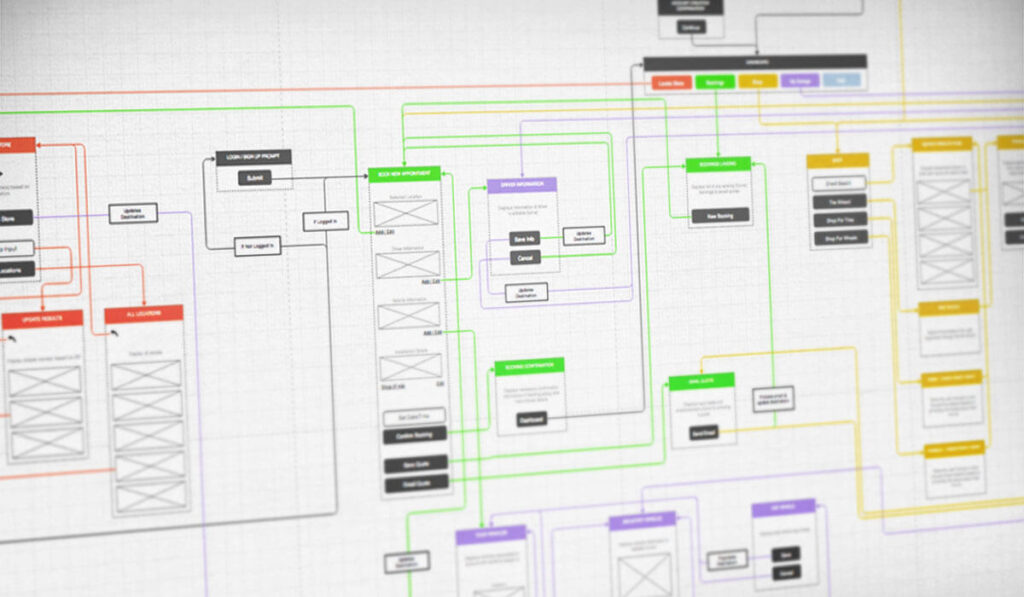Information Architecture: Foundation to a Great Product

Information Architecture (IA) is the master key that opens the door to enhanced usability, seamless user experiences, and business success. Imagine your digital space as a vast library, where the books are your content, and IA is the guide that helps users find precisely what they seek with ease and delight. We shall delve into the transformative influence of IA and its pivotal role in shaping digital experiences.
What is information architecture (IA)?
Information architecture (IA) is about organizing and naming content effectively to enhance user experience. It ensures users can easily find information and perform tasks by creating a coherent structure within a system. In UX, IA improves usability by supporting intuitive navigation, clear messaging, and efficient workflows. It involves creating site maps, wireframes, and tools for information management. The goal is a seamless, user-friendly experience that aligns with the target audience’s needs and preferences.
Why do I need an IA for my product and business?
Information architecture is essential because it provides the structural framework for organizing and presenting content within a product, ensuring that users can easily access and navigate the information they seek. An effective IA enhances user experiences, boosts findability, supports content management, aids in SEO, and allows for scalability, all of which are crucial for the success of digital products and businesses in today’s information-driven landscape.
What are the benefits of having a well-organized information architecture for my business?
Your IA serves to guide users in understanding their location, the content they’ve discovered, what’s available, and what to anticipate. It influences word choices, user interface design, and interaction design, playing a role in wireframing and prototyping. Here are some important business goals IA helps you achieve:
Improved user experience:
A well-structured IA ensures that users can easily find the information or products they seek. It also ensures a consistent and cohesive user experience across different parts of a digital product. This results in improved user satisfaction and can lead to increased customer loyalty. Information architecture (IA) shapes user experience (UX) by:
- Improving Usability: IA simplifies navigation, making it easy for users to find information and complete tasks.
- Enhancing Organization: It provides a logical content structure, allowing users to understand and explore the digital space effortlessly.
- Optimizing Findability: Effective IA reduces search time, ensuring users can quickly access information.
- Consistency and Familiarity: A coherent IA promotes a consistent UX, helping users feel at home in the digital environment.
- Reducing Cognitive Load: Clear IA minimizes mental effort during navigation, enhancing overall satisfaction and efficiency.
Efficient content management
IA facilitates the efficient organization and management of digital content. It simplifies the process of adding, updating, and removing content from websites or apps.
Improved SEO
When content is logically structured and labeled, it’s more accessible to search engines. This can boost a website’s search engine ranking, leading to increased organic traffic.
Reduced support costs
Businesses can save money by avoiding the need for extensive restructuring or redesign later on. A strong IA framework prevents costly rework. When developers have a clear IA to follow, it streamlines the development process. This results in shorter project timelines and lower costs.
Scalability
Businesses can easily scale their digital products and content when an effective IA is in place. It supports growth and expansion without a significant increase in complexity.
Personalization
IA can underpin personalization efforts, helping businesses provide tailored content or product recommendations based on user behavior and preferences.
Customer retention
IA makes it easier for customers to find the information they need, complete tasks efficiently, and have a positive overall experience. This can lead to increased customer satisfaction and loyalty, which can lead to repeat business and referrals.
How can I gain competitive advantage with IA?
By carefully considering each of the components of IA and how they can be used to improve the user experience, increase sales and conversions, improve SEO, reduce support costs, and improve team collaboration, you can create an IA that will give you the edge you need to succeed in today’s competitive marketplace. A well-structured IA helps users find what they need quickly, enhancing satisfaction and loyalty, which can give your business an edge in the market.
Who needs IA?
Information architecture (IA) is crucial for digital spaces like websites and databases. It ensures easy information access and user-friendly structures. If your platform faces usability issues, consulting an Information Architect is vital. IA can significantly improve digital user experiences, helping websites provide easy access to information and meet business requirements. Many web design problems occur due to a lack of proper IA structure.
What are the main components of IA?
Organization system
How is the information structured and categorized? This includes:
- Hierarchies
- Taxonomies
- Metadata
Labeling system
How is the information labeled and named? This includes things like:
- Page titles
- Headings
- Navigation labels
- Search
Navigation system
How do users move around the information? This includes:
- Menus
- Breadcrumbs
- Search bars
- Menus
- Hyperlinks
- Site Map
- Tree structure
How is sitemap different from information architecture?
A site map visually outlines a website’s structure, showing its pages and connections. Information architecture (IA) is the broader strategy for organizing content and enhancing user experiences. Site maps are a part of IA, representing the site’s hierarchy, but IA encompasses the overall content organization and accessibility approach, prioritizing user needs.
Searching system
How do users find specific information? This includes things like simple search bars, advanced search filters, and faceted search. The designer need to keep in mind about the following:
- What search choices are available to users?
- In what format are the search findings shown to users?
- What is the mechanism behind the search engine?
- Is it possible to enhance search queries for better results?
- Can the results include a “top recommendation”?
- Can the results also suggest “related content”?
Creating an IA that is easy to use
How do users decide where to go next?
The user has a perception of the usefulness of a piece of information relative to their goal. They decide where to go next by following the information scent that leads them to the information they need or the task they want to complete. This is known as information scent.
For example, a user is more likely to click on “Product Details” than “Learn More” on an e-commerce site.
Information scent is an important concept for information architects to consider, as it can have a significant impact on the user experience.
How to create an effective IA?
- Understand your users: The first step to creating an easy-to-use IA is to understand your users. What are their needs? What are their goals? What are their pain points? Once you understand your users, you can design an IA that caters to their needs and helps them achieve their goals.
- Use a clear and consistent structure: A well-structured IA is easy to use and understand. Use a clear and consistent hierarchy to organize your content. Use clear and concise labels for your pages and navigation elements.
- Make it easy to navigate: Make it easy for users to find the information they need by providing clear and concise navigation. Use menus, breadcrumbs, and search bars to help users move around your website.
- Test your IA with users: Once you have created an IA, test it with users to make sure it is easy to use. Ask users to complete tasks and provide feedback on your IA. Make changes to your IA based on user feedback.
How can we strategize managing IA?
An IA strategy is a plan for managing the IA of a website or product. It should include the following:
- Goals: What do you want users to be able to do with your website or product?
- Audience: Who is the target audience for the IA? What are their needs and goals?
- Content: What content will be included in the IA? How will the content be organized?
- Structure: What hierarchical structure will be used for the IA?
- Navigation: How will users navigate through the IA?
- Governance: Who will be responsible for maintaining and updating the IA?
Who creates an IA?
The responsibility for IA within your organization can vary depending on the size and structure of your organization. In some organizations, IA is a dedicated role. In others, IA is the responsibility of a team of people, such as web designers, UX designers and content strategists.
What are the best practices for designing and implementing an effective information architecture?
Best practices for effective IA:
- User-centered approach: Prioritize user needs and preferences in your IA design, ensuring it aligns with their goals.
- Logical organization: Organize content logically, creating a structure that’s intuitive for users.
- Consistency: Maintain consistency in labeling, navigation, and layout throughout your digital product.
- Scalability: Design an IA that can accommodate future content growth and changing user needs.
- Testing and iteration: Regularly test and refine your IA based on user feedback and evolving requirements.
Dos and Don’ts for Effective IA:
Dos:
- Involve users in the IA design process through testing and feedback.
- Maintain a balance between depth and breadth in your IA structure.
- Prioritize clear and meaningful labels for content.
- Create pathways for users to easily access essential information.
- Consider mobile and responsive design for a seamless user experience.
Don’ts:
- Create overly complex or deep navigation structures that confuse users.
- Use jargon or ambiguous terminology in labels.
- Overlook the importance of user testing and iterative improvement.
- Ignore the mobile-friendliness and adaptability of your IA.
- Design in isolation; involve cross-functional teams in IA development.
Why is design-driven innovation essential for a successful information architecture?
Design-driven innovation is crucial for successful information architecture because it ensures that the IA is user-centered, intuitive, and aligns with user needs, enhancing overall usability and user satisfaction.
What role does user experience design play in the context of information architecture?
User experience design plays a pivotal role in information architecture by focusing on creating intuitive, visually appealing structures that make it easy for users to access and interact with information, contributing to better user engagement and satisfaction.
Why do I need a design studio to build an IA for my product?
Engaging a design studio for your information architecture can be helpful as:
- Design studios specialize in creating user-centered structures that ensure optimal user experiences.
- We expertise in IA which guarantees that your product’s information is logically organized, enhancing usability and making it easier for your users to access content.
- Our external perspective provides fresh insights and innovative approaches, streamlining IA development for a more efficient solution that aligns with your business objectives.
How can I measure the ROI of investing in information architecture?
To measure ROI for IA, monitor factors such as:
- improved user satisfaction
- lower bounce rates
- shorter development timelines
- streamlined content updates.
An efficient IA should lead to higher user retention, improved search rankings, and cost savings in content management and development. By quantifying these improvements, you can calculate IA’s ROI.
How can I keep my information architecture up-to-date as my business grows and changes?
- Regularly review your content: Make sure your content is still relevant, accurate, and consistent with your business goals.
- Conduct user research: Understand how your users are interacting with your IA and identify any areas where they are struggling.
- Make incremental updates: Don’t try to redesign your IA from the ground up every time your business changes. Instead, make small, incremental updates as needed.
- Use a CMS with good IA support: A good CMS will make it easy to manage your IA and make updates
What are the long-term implications of our IA decisions?
IA decisions can have a significant impact on the long-term success of a website or product. A well-designed IA can help to improve the user experience, increase sales and conversions, and improve SEO. However, poorly designed IA can lead to a number of problems, such as user frustration, lost sales, and poor SEO performance.
When making IA decisions, it is important to consider the long-term implications. For example, if you are planning to launch new products or services in the future, you need to make sure that your IA is flexible enough to accommodate those additions
Conclusion
One thing becomes crystal clear to us is that IA is more than just an organizational framework. It’s the compass that guides users through the labyrinth of information, ensuring that they reach their destination effortlessly. The power of IA transcends mere organization; it enhances user engagement, boosts satisfaction, and drives business objectives.







